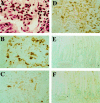Acid regulates inflammatory response in a rat model of induction of gastric ulcer recurrence by interleukin 1beta
- PMID: 11358894
- PMCID: PMC1728306
- DOI: 10.1136/gut.48.6.774
Acid regulates inflammatory response in a rat model of induction of gastric ulcer recurrence by interleukin 1beta
Abstract
Background: In a previous study we showed that interleukin 1beta (IL-1beta) caused recurrence of gastric ulcers in rats, and that adhesion molecules (intercellular adhesion molecule 1 and leucocytic beta2 integrins) play a role in this recurrence. Although gastric acid plays an important role in many types of gastric injuries, including peptic ulcer recurrence, the mechanism(s) remains unclear.
Aims: To examine the involvement of gastric acid in induction of ulcer recurrence by IL-1beta, and to investigate the role of gastric acid in inflammatory responses during ulcer recurrence.
Methods: Rats with healed ulcers were used. Rats were given 1 microg/kg IL-1beta intraperitoneally. Another group of rats was given 20 mg/kg omeprazole for three days to inhibit acid secretion, and received IL-1beta 20 hours after the first administration of omeprazole. They were then given 0.15 N HCl or vehicle at 0, 12, 24, and 36 hours after IL-1beta treatment. Some rats were given acid alone at the same time points. Expression of adhesion molecules was examined immunohistochemically and concentrations of IL-1beta and tumour necrosis factor alpha (TNF-alpha) were measured by ELISA in scar tissue 24 hours after IL-1beta treatment.
Results: IL-1beta increased expression of adhesion molecules and concentrations of IL-1beta and TNF-alpha in scar tissue by 24 hours after IL-1beta treatment, and nine of 11 healed ulcers had recurred by 48 hours. Omeprazole inhibited the effects of IL-1beta. HCl acid abolished the inhibitory effects of omeprazole. Acid alone affected neither expression of adhesion molecules nor cytokine concentrations, and did not cause recurrence.
Conclusions: Gastric acid is required for recurrence of gastric ulcers caused by IL-1beta, and gastric acid stimulates the inflammatory process in scarred mucosa during ulcer recurrence.
Figures






Comment in
-
The importance of interleukin 1beta in Helicobacter pylori associated disease.Gut. 2001 Jun;48(6):743-7. doi: 10.1136/gut.48.6.743. Gut. 2001. PMID: 11358884 Free PMC article. No abstract available.
References
Publication types
MeSH terms
Substances
LinkOut - more resources
Full Text Sources
